Introduction
Cosmetic jaw surgery is also known as orthognathic surgery, a term which is more appropriate. Orthognathic surgery involves correction of dentofacial deformity but not always for cosmetic reasons. We are all used to recognising crowded / irregular teeth or rather malocclusion which may require orthodontic treatment. Very often malocclusion is associated with skeletal discrepancy. Skeletal discrepancy has a strong racial characteristic due to genetic influences. There is disharmony in the relationship of facial skeleton to the skull base. In other words the skeletal framework of the midface, maxilla and mandible are not in harmony (or rather acceptable proportions both in the vertical and horizontal planes) and hence termed as dentofacial deformity.
Orthognathic surgery has been developed to correct dentofacial deformity by allowing repositioning of the dentoalveolar segments, mandible, maxilla and parts of midface to a desired position for optimum function, aesthetics and stability.Correction of these deformities requires a team approach between Oral & Maxillofacial Surgeons and Orthodontists mainly and occasionally other dental specialities like Paedodontists, Prosthodontists and Periodontists.
Who Needs It?
Those with improper bite or jaws that are positioned incorrectly. Upper and lower jaw may grow at different rates resulting in a host of problems. Problems may not be solved by only correcting the arrangement of the teeth which will not improve the bite and jaw relationship.
Signs
- Elongated lower jaw (lower front teeth in front of the upper)
- Lower jaw asymmetry
- Shorter lower jaw
- Strong chin
- Chin asymmetry
- Upper jaw too forward
- Gummy smile (excessive gingival show on upper jaw)
- Upper and lower front teeth are not in contact when biting (open bite)
- Severely crowded upper and lower teeth due to narrow jaws
- Marked protrusion of upper and lower front teeth
- Difficulty in chewing effectively
- Incompetent lips
- Straining of lower lip to achieve lip seal
- Snoring
- Flattened cheek bone
- Lisping of speech
Adverse Effects
- Irregular teeth causing difficulty in maintaining oral hygiene
- Impaired mastication and in severe cases affects digestion / general nutrition
- Low self-esteem due to the appearance of the jaw / arrangement of teeth
- May cause pain over the TMJ (Temporomandibular joint)
- Sleep apnoea
- Difficulty in pronouncing certain words or speech in general
Treatment
Patients will require a thorough assessment in a combined (Oral Surgery – Orthodontic) clinic with appropriate radiographs of the facial skeleton and study models of the dentition. Normally the patients will undergo pre surgical orthodontic treatment for a period of six months to two years before the orthognathic surgery. The surgery in most circumstances will be done upon cessation of growth (17 years of age for females and 18 years for males). Surgery will be performed under general anaesthesia within a hospital environment. Following surgery the patient will require post-surgical orthodontic treatment for a period of six months to a year.
There are various jaw surgeries that could be carried out depending on the deformity present. These include segmental osteotomies, lower jaw set back or advancement, upper jaw impaction or advancement, chin reduction or advancement, mid face advancement, distraction osteogenesis procedures for upper or lower jaw, and finally facial bone augmentation. The bone fragments are fixed in their new position with titanium bone plates and screws. These bone plates and screws are inert and do not usually require removal.
Recovery
Patients may need a hospital stay of three to five days post operatively depending on jaw surgery performed and the amount of swelling and discomfort. During the healing phase, patients may be placed on light elastics to guide the jaws into their new positions. Active orthodontic treatment may start subsequently. The patient will be on nourishing liquid diet for at least two weeks immediately after the operation followed by soft diet for another one month. Maintaining good oral hygiene is important during recovery. Depending on the pace of recovery patients may need about three weeks to a month of home rest before resuming their normal duties.
What are the possible problems?
- Facial swelling especially lower jaw and lips
- Numbness of lower lip and skin of the chin if lower jaw surgery
- Numbness of upper lip if upper jaw surgery
- Permanent numbness of the lips if nerve injury was more than usual
- Bleeding intra operatively which may require blood transfusion
- Unfavourable bone split / osteotomy
- Anaesthetic complications though rare
Clinical Pictures
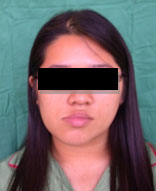 |
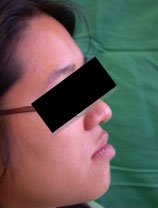 |
|
Before Operation |
|
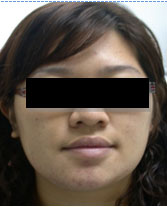 |
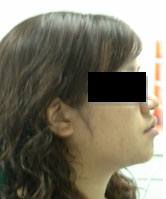 |
|
After Operation |
|
Case I – Jaw asymmetry with protuding lower jaw.
Procedure – Bilateral sagittal split osteotomy with differential setback and rotation on lower jaw
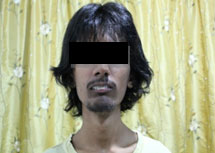 |
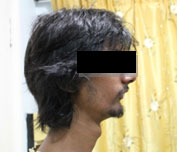 |
|
Before Operation |
|
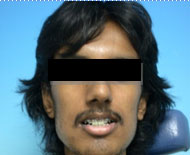 |
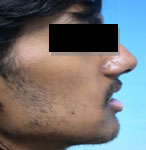 |
|
After Operation |
|
Case II – Small lower jaw
Procedure – Lower jaw advancement with distraction osteogenesis
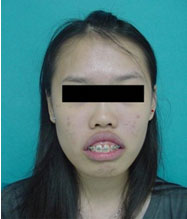 |
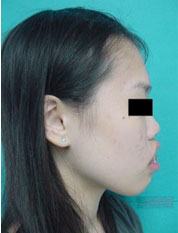 |
|
Before Operation |
|
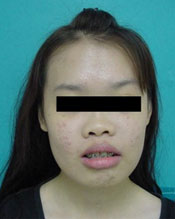 |
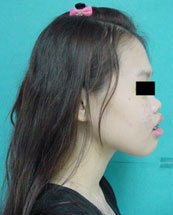 |
|
After Operation |
|
Case III – Long face with gummy smile
Procedure – Le Fort I osteotomy, superior impaction, anterior segmental setback and impaction of the upper jaw followed by bilateral sagittal split osteotomy of the lower jaw
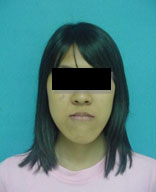 |
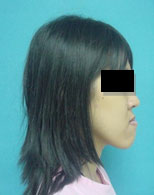 |
|
Before Operation |
|
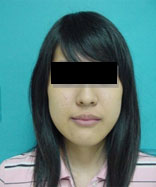 |
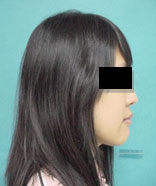 |
|
After Operation |
|
Case IV – Strong lower jaw
Procedure – Bilateral sagittal split osteotomy and set back with chin height reduction
| Last Reviewed | : | 25 April 2014 |
| Writer | : | Dr. Ravindran a/l Murugesan |
| Accreditor | : | Dr. Abdul Latif b. Abdul Hamid |
| Reviewer | : | Dr. Kok Tuck Choon |







